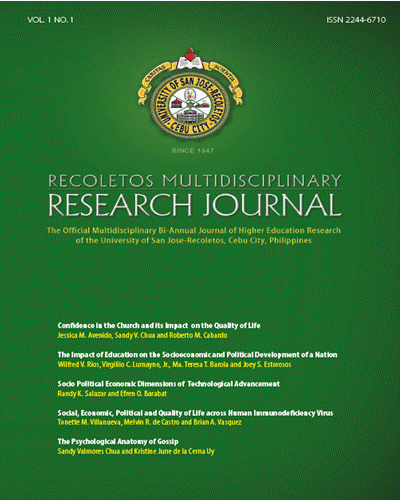The Psychological Anatomy of Gossip
DOI:
https://doi.org/10.32871/rmrj1301.01.05Keywords:
self-concept, propensity to gossip, projection of life issues, gossip episodeAbstract
Gossip’s unrelenting presence throughout time, age, gender, and social structure has sparked a lot of questions regarding its occurrence. Although studies have already been made regarding gossip, it has remained to be an understudied happening in the area of psychological research. This paper examines gossip from a psychological standpoint, looking into the relationship between a person’s self concept and their propensity to gossip. The theory formulated in this study will explain, describe, and predict the nature of gossip as a projection of basic life issues. As such, this paper gives another perspective into how gossip can be viewed, examined, and understood.
References
Adler, A. (1964), Superiority and social interest: a collection of later writings. H. L. Ansbacher and R. R. Ansbacher (Eds.), Evanston, IL:
Northwestern University Press.
Ayim, M. (1994). Knowledge through the grapevine: Gossip as inquiry. In R.F Goodman & A.
Ben-Ze‘ev (Eds.), Good Gossip (pp. 85-99). Lawrence, KS: University of Kansas Press.
Baumeister, R.F., Zhang, L., & Vohs, K.D. (2004). Gossip as cultural learning. Review of General Psychology, 8, 111-121.
Ben-Ze‘ev, A. (1994). The vindication of gossip. In R.F Goodman & A. Ben-Ze‘ev (Eds.), Good Gossip (pp. 11-24). Lawrence, KS: University
of Kansas Press.
Blumberg, H. H. (1972). Communication of interpersonal evaluations.Journal of Personality and SocialPsychology, 23, 157–162.
Dunbar, R. I. M., Marriott, A., & Duncan, N. D. C.(1997).Human conversational behavior. HumanNature, 8, 231–246.
Eder, D. &Enke, J.L. (1991). The Structure of Gossip: Opportunities and Constraints on Collective Expression among Adolescents(pp.494-508)
American Psychological Association
Festinger, L. (1954). A theory of social comparison processes. Human Relations, 7, 117-140.
Foster, E. K. (2004). Research on gossip: Taxonomy, methods, and future directions. Review of General Psychology, 8, 78-99.
Gottman, J., &Mettetal, G. (1986). Speculations about social and affective development: Friendship and acquaintanceship through adolescence. In J. Gottman & J. Parker (Eds.), Conversations of friends: Speculations on
affective development (pp. 192-237.). New York: Cambridge University Press.
Grosser, T. J., Lopez-Kidwell, V., & Labianca, G. (2010). A social network of positive and negative gossip in organizational life. Group & Organization Management, 35(2), 177-212.
Hallett, T., Harger, B., & Eder, D. (2009). Gossip at work: Unsanctioned evaluative talk in formal school meetings. Journal of Contemporary
Ethnography, 38(5), 584.
Horney, Karen.(1945) Our inner conflicts. New York: W.W. Norton & Co.
Leaper, C., & Holliday, H. (1995).Gossip in same gender and cross-gender friends’ conversations.Personal Relationships, 2, 237–246.
Levin, J., & Arluke, A. (1987). Gossip: The Inside Scoop. New York : Plenum Press.
Machiavelli, N. (1995). The prince and other political writings. London: Everyman. (Original workpublished 1516)
Mettetal, G. W. (1982). The conversations of female friends at three ages: The importance of fantasy, gossip, and self-disclosure.
Unpublished doctoral dissertation, University of Illinois, Urbana.
Rogers, Carl. (1959). A Theory of Therapy, Personality and Interpersonal Relationships as Developed in the Client-centered Framework. In (ed.) S.
Koch, Psychology: A Study of a Science. Vol. 3: Formulations of the Person and the Social Context. New York: McGraw Hill.
Rosnow, R.L. (2001). Rumor and gossip in interpersonal interaction and beyond: A social exchange perspective. In R. Kowalski (Ed.), Behaving Badly: Aversive Behaviors in Interpersonal Relationships (pp. 203-232).
Washington DC: American Psychological Association.
Rosnow, R. L., & Foster, E. K. (2005). Rumor and gossip research. APA Online: Psychological Science Agenda, 19(4).
Spacks, P. M. (1982). In praise of gossip. HudsonReview, 35, 19–38.
Turcotte, D. (2012). Gossip and the Group: A Self- Categorization Perspective.
Wert, S. R., & Salovey, P. (2004). A social comparison account of gossip. Review of General Psychology , 8, 122-137.
Wilson, D. S., Wilczynski C., Wells A., and Weiser, L. (2000). Gossip and Other Aspects of Language as Group-Level Adaptations. In C. Heyes
(Ed) Cognition and Evolution,(pp. 347-366). Cambridge: MIT Press.
Yerkovich, S. (1977).Gossip as a way of speaking. Journal of Communication, 26, 192–196.
Downloads
Published
How to Cite
Issue
Section
License
Copyright of the Journal belongs to the University of San Jose-Recoletos


